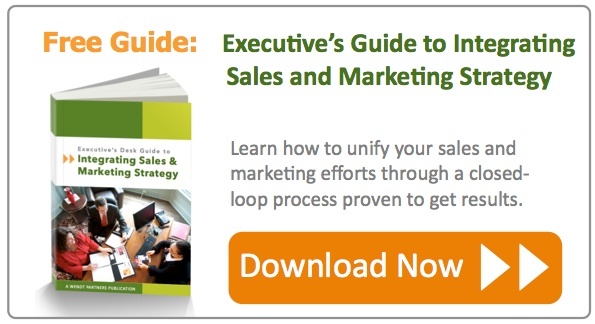6 Ways to Stop Throwing Away Your B2B Marketing Budget in 2014
 It's 2014. Your B2B company produces cutting-edge products or delivers state-of-the-art services. So why are you still spending on marketing like it's 1999? Chances are, your company is bleeding marketing dollars in ways you didn't even consider, precisely because you haven't had the time to think about how to do things differently. In the absence of a clear new direction, most companies fall on the old, tried-and-true approach…even if it no longer works. And chances are, your marketing is not performing for you at the level it could. As a CEO, here are six ways to stop spending the wrong way on marketing:
It's 2014. Your B2B company produces cutting-edge products or delivers state-of-the-art services. So why are you still spending on marketing like it's 1999? Chances are, your company is bleeding marketing dollars in ways you didn't even consider, precisely because you haven't had the time to think about how to do things differently. In the absence of a clear new direction, most companies fall on the old, tried-and-true approach…even if it no longer works. And chances are, your marketing is not performing for you at the level it could. As a CEO, here are six ways to stop spending the wrong way on marketing:
1. Cancel Illogical, Outdated Print Spending
Print is dead. Long live print! Contrary to popular belief, print is not dead. What is dead, however, is the way you have been using it. If you're still sending out indiscriminate direct mail campaigns, printing 100-page catalogs and creating endless reams of marketing collateral -- simply put, you're doing it wrong. Ask yourself this question: If you walked into the marketing department of your company right now, and looked around (or in the closet where you keep your trade show booth), how many boxes of never-distributed marketing literature would you find? One way to be sure that you're doing the wrong kind of print spending is to ask if you're still doing large-scale offset print runs. In the past, the only way to do high-quality printing cost-effectively was to produce a large print run. This meant that marketing literature had to be designed so that it would last as long as possible – which generally resulted in generic, largely useless collateral. Today, digital printing has come of age and well-designed, high-quality digital print runs are equal to offset in quality and value. That means you should be producing smaller print runs, more specific collateral and customized deliverables.2. Stop Buying Google AdWords Without Long-Tail Keywords
So you decided to refocus and commit to digital marketing, and you know that one of the key goals is to 'get found' on Google. What comes after that? For many companies, the next step is to go online and buy Google AdWords to get themselves to the top of the search engine quickly. The problem is, do you really have any idea what it means to "get to the top of Google"? Google is not a page – Google is a database… a database that produces 500 million unique searches each day. In other words, Google is not the digital equivalent of the Yellow Pages, where a company that sold accounting only needed to buy a top placement on the "Accountants" page in the directory. In the world of Google, there are an infinite number of different pages– not just one. Many CEOs quickly get overwhelmed and just decide to buy AdWords for their general product or service category. Being on the top page of Google for "Accounting" is a lot more expensive -- and an enormous waste of money – if being on the top page of Google for "small business CPA firm Northern NJ" would reach your target market. Long-tail keywords use three or more words and often more, and represent highly specific searches – and they represent the majority of web searches. They should also be at the core of your strategy.3. Fire Your Magical, Mysterious SEO Consultant
There is no doubt that building and maintaining a search-engine friendly website is a cornerstone for modern marketing success. But the days of the mysterious 'black box' SEO consultant are numbered, and they should be. Google has made two major recent updates – called Penguin and Panda – that make technical shortcuts far less effective. Yes, your SEO 'expert' has lots of methods for gaming the system, by overloading your site with keywords; creating link farms that artificially increase page rank; creating phantom pages, and more. The only problem is, doing basic, page-by-page work to make your site more interesting and relevant to customers would achieve the same results.4. Quit Paying Interns to 'Do' Social Media
Social media has blasted onto the marketing scene as the latest 'must-have' accessory for an already overwhelming list of marketing priorities and moving parts. In the early days of social media, the only real goal was to secure a 'presence' and broadcast company information through channel. Did your A/E/C firm win a new project? Well, don't just mention it on your website…share it on Twitter, Facebook and LinkedIn as well! But in 2014, that's not really the point of social media – today, it's about creating conversations, developing relationships and building communities. In other words, your college-student intern can't do the job justice. It's time to recognize social media as a strategic asset, and stop putting it in the marketing sidecar. Get rid of the intern.5. Don't Build a New Website (Unless…)
Do you feel like your website is outdated? Outmoded? Boring? Are you embarrassed to send prospects to the website for fear of looking silly or coming off with a lack of credibility? You may think that the obvious solution to this problem is… a new website! Marketing agencies certainly will tell you that – after all, your old website is the nail that perfectly fits the hammer they are selling. But the reality is, your website may need replacement…and it may not. Perhaps your site can be easily upgraded, or maybe the problem isn't the site, but rather the fundamentally stale content that's on it. Have your team commit to regular content upgrades, or swapping out old images for new ones. The best business case for building a new website today is not about looking a little better: it's about generating new leads through powerful content and a strong, deep user experience.6. Stop Hiring the Wrong Marketing People
Maybe you're proud of your marketing team and confident that you've taken the time to invest in your people. You have an in-house marketing manager and perhaps one or a few other professionals in the group, too. And that could be invaluable – it certainly should be, considering that it represents the greatest slice of your marketing spend. The problem is that marketing today is not the field that it was just a few short years ago. It takes cutting-edge thinking and constant professional development to stay on top of today's marketing profession, and most marketers can't keep up. If you're reticent to accept new ideas and loathe investing in change, you're compounding the problem, too. The result is a very expensive and completely ineffective team that's busy making tweaks here and updating documents there and doing nothing to contribute to the bottom line. Redeploy them, retrain them, or help them find a new job.
The time for change is now – the competitive landscape demands it. The first step to making the right investments is to stop making the wrong ones.
Image Credit: TaxCredits @ Flickr / TaxCredits.net (Creative Commons)


